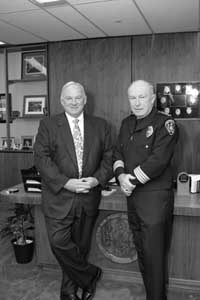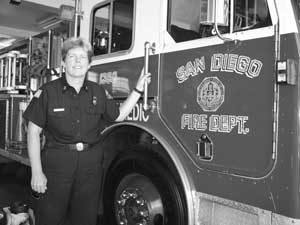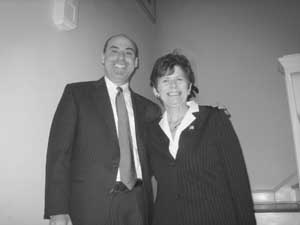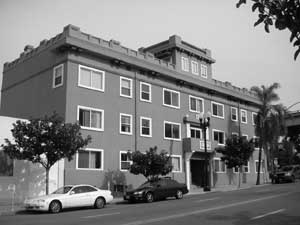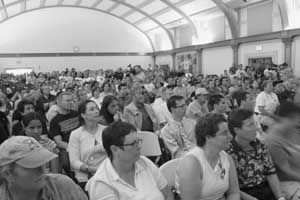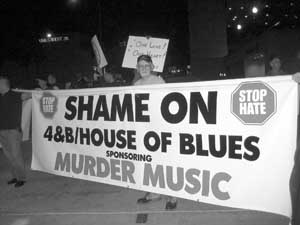-
- Calif. diocese snubs Episcopal Church, moves toward break
- Man former N.J. governor identified as lover says he believes McGreevey isn’t gay
- Obama discusses sexuality, spirituality at AIDS conference
- Same-sex marriage ban goes before Massachusetts high court
- For gay activists, it’s still political season in N.J.
- Virginia appeals court: Vt. has say in lesbian custody battle
- National News Briefs
- World News Briefs
feature
GLT People of 2006
Published Thursday, 07-Dec-2006 in issue 989
From unprecedented victory to craven acts of violence, 2006 was filled with individuals and events that either enhanced the quality of life for gay, lesbian, bisexual and transgender San Diegans or, at a minimum, galvanized them to reclaim their neighborhoods and unite against hate and intolerance.
With a new year on the horizon, the Gay & Lesbian Times is continuing its annual tradition of honoring those who have shown unwavering support for the community, worked to advance GLBT equality or served as role models by living with integrity. The following encapsulates some of this year’s most inspiring and disheartening people and proceedings.
Persons of the year
An interview with Mayor Jerry Sanders and Police Chief William Lansdowne
It was clear that this year’s Person of the Year award should be shared by two stalwart civic leaders: Mayor Jerry Sanders and Police Chief William Lansdowne.
While the Gay & Lesbian Times is proud to bestow them the honor, given the brutal events of last summer that led to their selection, it is a bittersweet recognition.
At around 10: 45 p.m. on June 29, six men were barraged with anti-gay epithets and attacked with baseball bats and a knife as they exited San Diego’s LGBT Pride festival in Balboa Park. One man was stabbed in the back while another sustained a beating that left almost every bone in his face broken and his skull fractured. It was by far the worst case of violence in the 30-year history of the city’s Pride celebrations.
While San Diegans, gay and straight, were quick to denounce the attacks, it was the unified front of Sanders and Lansdowne early the next morning that carried the most weight. Together, standing before the press, the two high-ranking officials sent an unequivocal message that hate and violence against GLBT citizens or any other group would not be tolerated in San Diego.
In less than a week, three of the men involved in the attack were in custody, charged with attempted murder and assault and battery with a deadly weapon. The attempted murder counts each carried a hate crime enhancement charge.
A 15-year-old El Cajon teen was sentenced to 10 years in a California youth detention center for beating and stomping on the victims. As adults, James Carroll and Lyonn Tatum received 11 years and eight years, respectively, for the attacks. Kenneth Lincoln received 32 months in jail for helping cover up the crimes.
The morning after the attacks, Sanders addressed the at-large suspects directly. “You are cowards,” he told them.
The Gay & Lesbian Times met with the mayor at his office last week, on a drizzly Monday afternoon. The affable, well-liked politician was in good spirits, though one could sense the weight of a severely debt-ridden city on his shoulders – a huge lump of coal he received from previous administrations that has made protecting San Diego’s citizenry a precarious balancing act for both him and Lansdowne.
The morning following the attacks, Sanders said he received a call from his spokesperson, Fred Sainz, alerting him to the situation. He quickly conferred with Lansdowne to “pull out all the stops.”
The goal of their resulting press conference was twofold, Sanders said – to inform the community as quickly as possible and to send a clear message that hate crimes would not be tolerated.
Speaking with the Gay & Lesbian Times via phone, Lansdowne explained: “It was to assure the LGBT community that we took this very seriously … that we were going to use unlimited resources to solve it quickly. We would be able to get enough information out quickly to develop a source from the community, and that’s exactly what occurred.”
Lansdowne said he heard about the attacks late that evening and phoned Assistant Police Chief Cheryl Meyers to get a team together to work on the case.
“We met early that morning, around 6:00 a.m., sat down and planned a strategy … and brought in the extra resources,” Lansdowne said. “We had lots of witnesses that needed to be contacted and worked with. We contacted Crime Stoppers to get the information out.”
Sanders and Lansdowne credited community members for relaying crucial information that helped root out the perpetrators.
“It was the community that stepped forward that really helped us in solving the case,” Lansdowne said. “That’s a long-term relationship of trust that we built over quite a few years, beginning with Jerry Sanders when he was chief of police.”
Sanders commended the police officers on the case, including SDPD detectives Kim Robinson and Tim Johnson, who worked 40 hours straight until the attackers were apprehended.
Despite his shared view that the attacks were hate-motivated, Sanders said he is not certain how effective hate crime statutes are as a deterrent.
“I do think it has a place, though,” Sanders said. “I think it sends out a very strong signal to the rest of society … but frequently the people that do these things, there’s nothing that’s going to dissuade them. It’s no different than saying, ‘Use a gun; go to jail.’”
In April, Lansdowne touted San Diego as having one of the lowest hate crime levels in the state. While it has decreased over the last four years, he said, “Unfortunately, not all hate crimes are reported, and we encourage people to step forward so we can investigate them and make the arrest.”
Sanders said the response he received from his statement was mostly positive.
“I live in Kensington,” he said. “I had neighbors stop by [and say] they were really proud. Going into Starbucks and going into different places, people said they felt really good that they saw me come out like that…. I think they’ve seen government pretty silent on those issues.”
Sanders said he doesn’t feel that the response would have been as positive had he made such bold statements when he first took over the reins as police chief in 1993.
“When I was a cop, the feelings were not the same,” Sanders said. “There was still hysteria, or homophobia. I see the cops now and I think … especially in the gay-lesbian community, they’ve done a much better job. There’s been leadership over the years that has helped. Some of our officers came out and said they were gay or lesbian. The fact that they work around people and learn to respect them as people has helped.”
Despite the speed with which the attackers were apprehended and brought to justice, a series of robberies and violent attacks in Hillcrest, Mission Hills and North Park have taken place since Pride weekend, including several attacks on gay men, though it is not entirely clear whether they were hate-motivated.
As San Diego police officers are wooed away by higher paying positions at other law enforcement agencies and industries, San Diego’s police force – already short about 200 officers – is a cause for concern.
In hopes of making law enforcement a more attractive option in San Diego, Sanders said the police department has been working with a consultant to overhaul its antiquated recruitment procedures. A new recruiting program is scheduled to go into effect after the first of the year.
“If you look at our recruiting program, it’s the same one that recruited me in 1970,” Sanders said. “If you look at our population now, there’s lot of piercings, a lot of tattoos, a lot of facial hair – it’s a very different group of people than when I came on and you had the white sidewall haircut…. We’ve got to display a department that’s open to some things and we have to be able to appeal to that generation to show them why it’s exciting to be a cop.”
Regarding the ongoing exodus of officers, Sanders maintained his promise that police officers will see an increase in pay next year.
“We’ll bring the pay comparable, as close as we can, over the next few years,” Sanders said. “I understand they want a pay increase. They’ve gone two years without it.”
Though Sanders’ “managed competition” ballot initiative, Proposition C, passed by a healthy margin, some were uncomfortable with the absence of language prohibiting the outsourcing of public safety services. Sanders reaffirmed his pledge that San Diegans would not one day be connected to Calcutta when dialing 911. Still, he maintained, comparable wages in a city besieged by debt means fewer overall employees in public safety and elsewhere.
To that end, task forces and specialized detective units are being temporarily disbanded and the officers put back on patrol.
“I’d rather have fewer well-paid, well-trained, well-equipped city employees than a lot of people who don’t have the equipment, don’t have the training and aren’t paid well,” said Sanders, noting that there are currently 46 people going through the police academy.
“We’re trying to make due with what we have,” Sanders said. “I think that once we announce some of the pay increases and things like that, it’ll be helpful in recruiting and also retaining.”
During his tenure as police chief, from 1993 to 1999, Sanders marched each year in the Pride parade. As mayor, he has participated in The Center’s annual gala, AIDS Walk and a host of other events.
“I’ve always made it my practice, from policing on, that that’s a very important community to me,” Sanders said. “I’m very involved in it and I’m going to continue to be, no matter what people have to say about it.”
Lansdowne said he appreciated the recognition and support he has received from the GLBT community.
“The best and biggest parade in the city of San Diego is always the gay Pride parade,” Lansdowne said. “Seldom in my 40 years of law enforcement have I ever felt more appreciated as [when] you walk down [past] that mile of cheering community members…. It’s a benchmark for the rest of the city.
“As you look at community partnerships, the LGBT community has always been first to step up and look for solutions for problems long term.”
People of note
Tracy Jarman
In June, Tracy Jarman was appointed by Mayor Sanders to fill the vacancy left by the resignation of former fire chief Jeff Bowman. Her June 26 confirmation by the City Council made her San Diego’s first female fire chief and the nation’s second openly lesbian fire chief.
Though Jarman was out to senior staff on the job, when tapped for the position she made the decision to be open about her sexuality.
“As a fire chief, that’s what I hold dearly – integrity, honesty, openness and the trust of the public and my personnel,” she said. “I needed to make sure that I was open about my lifestyle as I became fire chief.”
Since becoming a firefighter 22 years ago, Jarman has been coming out gradually on the job. She cited state Senator Christine Kehoe, Councilmember Toni Atkins and a handful of other firefighters who were out at work as role models.
Though she recognizes the historic significance of being San Diego’s first out fire chief, Jarman said her sexual orientation was not a factor in her selection. “That wasn’t a factor … and it hasn’t been a factor throughout the course of my career. I’ve just been promoted based on my qualifications and my capabilities. I just happen to also be gay.”
Since becoming fire chief, Jarman has been asked to speak at community events and helped Atkins kick off the Front Runners & Walkers of San Diego annual event during Pride weekend.
“The outpouring of support from the community was just fantastic,” Jarman said. “It’s a new role for me to be kind of public speaker for the gay, lesbian, bisexual and transgender community. It’s a whole new experience.”
Like Sanders and Lansdowne, Jarman faces some tough decisions as she tries to maintain staffing levels, equipment and training in a city with little cash to spare.
“We’re experiencing some of the similar exodus of seasoned firefighters going to other departments because of salary [and] benefit issues,” she said. “For the police there’s a statewide standard, so they can laterally transfer between departments. In the past, the fire service has not done that, but I’m starting to see a trend…. Going through another academy is sometimes a deterrent to changing departments. If they [remove that requirement], we’ll have people exiting the fire department the same as they’re exiting the police department.
“I know we have our challenges ahead of us financially,” Jarman said, “but I’m committed to doing whatever I can to keep the citizens safe.”
David Rubin
In another historic first, openly gay Deputy District Attorney David Rubin was elected to a San Diego Superior Court judgeship, beating out former district attorney Paul Pfingst. Rubin will be sworn in Jan. 8.
As a deputy district attorney, Rubin has successfully prosecuted many high-profile murder cases, including the 1998 murder of 9-year-old Matthew Cecchi and the slaying of Oceanside police officer Tony Zeppetella. Rubin was successful in obtaining the death penalty in both cases.
Though Ted Weathers was appointed a San Diego Superior Court judge in 2003, Rubin’s victory makes him the first openly gay man elected to public office in San Diego history.
“We hadn’t had an openly gay man elected to office in this county, ever, and we needed to bust that glass ceiling,” Rubin said. “When we did it, that was just sweet…. We got the Union-Tribune’s endorsement on top of all that.”
Rubin, who began his career as a law clerk in 1987, said he has always longed to serve on the bench.
“That’s a real career goal of mine and it all kind of came together.” Though Rubin said he believes he won based on his track record and the public’s trust in his ability to rule fairly and impartially, he said it is important that people from all walks of life are represented on the bench, including gays and lesbians.
“The judiciary is kind of the final arbiter of justice in society and in our community, and it needs to reflect the community that it’s going to sit in judgment of,” he said. “For me, for the community to feel like justice is being done and justice is happening [it needs] to see itself reflected in the judiciary and in other walks of life.”
Rubin said it is a sign of how far the GLBT community has come that gay-bating tactics used against him in the campaign fell flat.
“It didn’t resonate anywhere,” Rubin said. “It was hard to make that gay-bating strategy work in a situation where a candidate already had an established track record…. The issue of my [sexual orientation] did not have the kind of play that it might have had in years past.”
MARYAH
In 2005, MARYAH, the Metro Area Real Estate Professionals for Young Adult Housing, formed as a private organization to assist The Center with its Youth Housing Project. The project provides 23 units of affordable housing for youth between ages 18 and 24, focusing on GLBT youth who are homeless or transitioning out of foster care or group homes. So far, MARYAH has raised $30,000 to sponsor two apartments for The Center’s Youth Housing Project. Two of the group’s members, real estate agents David Yoder and Gail Hillen, helped The Center locate the property in 2005. The Center honored the group for its volunteer service at this year’s annual gala.
Happiest moment
The Center’s hate crime rally
Without a doubt, the happiest moment of the year was the sight of The Center filled to capacity with community members and public officials coming together as one to condemn the hate-fueled attacks in Balboa Park and to show that fear would not prevail.
More than 1,000 people showed up for the Aug. 4 event, which included speeches by the mayor, city attorney, police chief and others.
City Commissioner Nicole Murray-Ramirez announced the establishment of a permanent Hate Crime Reward Fund, presenting San Diego County Crime Stoppers and Police Chief Lansdowne with a check for $35,000 from community-based businesses. The fund will provide a financial reward to anyone who assists in the arrest and conviction of anyone who commits a hate crime in San Diego. Murray-Ramirez also announced the establishment of the Stonewall Citizens Patrol, a joint effort between American Veterans for Equal Rights (AVER) and the SDPD. The group, which held its first public training at The Center last week, will patrol and monitor Balboa Park, Hillcrest and North Park.
The rally was followed by a candlelight march from The Center to Obelisk Bookstore, where, in 1991, 17-year-old John Wear was stabbed to death as he walked down the street in an apparent hate crime.
Sanders recalled the attack as a turning point for San Diego law enforcement.
“That’s the first time the police department had really come to grips with hate crimes in a very organized, methodical way,” Sanders said. “To have somebody murdered for his [perceived sexual orientation] was something I don’t think that we had paid that much attention to in the past. I think we really came of age at that point and started to focus much more on hate crimes.”
Saddest moments
Fritz Klein, 1932-2006
Dr. Fritz Klein, a psychiatrist who studied human sexuality and helped launch the American Institute of Bisexuality, died May 24 at his home in San Diego.
Following up on the research of Alfred C. Kinsey, Klein believed that sexual orientation is fluid and changes throughout a person’s life. He believed Kinsey’s scale did not fully account for the number of men who are sexually active with both sexes, developing the Klein Sexual Orientation Grid to measure the complexity and fluidity of sexual orientation.
Klein, co-founder of San Diego’s Bisexual Forum, was present in 2004 as the bisexual and the transgender flags were hoisted at The Center, joining the rainbow and American flags in unison.
Six Degrees closes its doors
For four decades, the nondescript building at 3175 India St. held its own as a GLBT-owned and operated watering hole, first as The Swing and A Different Drum, serving a predominantly gay male clientele; later as Club Bombay and Six Degrees, both lesbian bars. Though there are several lesbian-themed nights at San Diego bars, Six Degrees was the city’s last remaining lesbian bar, and the end of an era.
The club was the site of numerous community fund-raisers. Gay & Lesbian Times columnist J.C. Porter compared the bar to an Arctic ice pack: “You just assume it will always be there.”
Hopes of the year
Taking back the streets: Stonewall Citizens Patrol
Though law enforcement moved swiftly to respond to the hate-motivated attacks in Balboa Park during Pride weekend, a series of violent robberies and assaults in Hillcrest and North Park continued soon thereafter. There have been more than 30 unsolved robberies in the Hillcrest and North Park areas during the past three months.
In response to the Pride attacks, American Veterans for Equal Rights (AVER) partnered with the San Diego Police Department to establish the Stonewall Citizens Patrol, a group of community volunteers trained to monitor the streets and prevent further violence. Though the group was formed to monitor the neighborhoods around Hillcrest during next year’s Pride celebration, it held its first training at The Center last week and started patrolling the streets last weekend.
“Police numbers are down, so it creates a target-rich environment for criminals,” said Citizens Patrol chair Bob Lehman. “Hopefully the extra presence of the Citizens Patrol along with community awareness can bring those numbers down.”
Stonewall Citizens Patrol urges those who do not feel comfortable talking to the police after an attack to contact The Center to address the danger.
For more information about the Stonewall Citizens Patrol, call Ben Gomez at (619) 459-1019 or e-mail him at elranchoboy@cox.net.
Once-a-day Atripla
Perhaps the greatest hope for people living with HIV came in the form of a single pill, when the Food and Drug Administration approved Atripla, a once-a-day treatment for HIV. The pill combines existing HIV drugs efavirenz (Sustiva), tenofovir (Viread) and emtricitabine (Emtriva).
FDA Commissioner Andrew von Eschenbach hailed Atripla as “a landmark for those suffering with HIV and AIDS.”
For years, community leaders David Contois and Steve Johnson have been working to address the crystal methamphetamine epidemic among gay men in San Diego.
Working in conjunction with The Center and Stepping Stone, they organized and helped fund a series of high-impact advertisements, posters and billboards. Employing the harm reduction model, Contois and Johnson have reached through the fog of addiction to deliver practical advice to the user: Meth is destroying your life and your relationships. If you can stop using, do so. If you’re not ready, here are some steps to reduce your use and protect yourself and others in the process.
This year, Contois, Johnson and others took their message online with the launch of Knowcrystal.org, offering the user “information without judgment.”
“Harm reduction is about acknowledging that people are on a continuum in their use,” said Contois, Knowcrystal.org’s project director. “Abstinence only reaches a small percentage of the population of users. Our message is targeted at a broad range of users who are in different stages of their use. What we try to do is say: ‘If you’re going to use, then drink water. If you’re going to use, then build downtime into that use schedule.’
“We are not condoning drugs,” Contois added. “We’re talking about things you can do to replace the risks that users face.”
Serving on the advisory committee to the project are Doug Braun-Harvey, Mick Frasca, Todd Gloria, Steven B. Johnson, Sheri Kirshenbaum, Bob Lewis, Patrick Loose, “Big Mike” Phillips, Andrew Printer, Frank Scarpaci, Chris Thomas and Tom Wall.
Menace of the year
San Diego ‘Reader’ publisher Jim Holman
Like a festering case of internalized homophobia, San Diego Reader publisher Jim Holman is a constant in this town.
Riding the bus from his Coronado home each morning to his office in Little Italy, the enigmatic purveyor of ostensibly open-minded culture puts his true heart and soul into his conservative Catholic sheet, San Diego News Notes. While Holman feels free to reject gay personal ads in San Diego’s largest “alternative” weekly, in News Notes his anti-gay and anti-choice voice reigns.
What does Holman do with the copious San Diego ad revenue he rakes in from his 100-plus-page publication, you ask? Alms for the homeless? Technological upgrades for disadvantaged schoolchildren? Nope.
While Holman has always been high on our list of menacing figures, this year he receives special recognition for pumping $3.5 million down the rat hole of statewide parental notification laws – a preliminary but key stepping stone to denying a woman’s right to an abortion. This year, Holman was the primary backer of Proposition 85, a retooled version of a previously failed initiative seeking to chip away at abortion rights.
Disappointments of the year
San Diego City Council: ‘The Negligent Five’
For more than a year, San Diegans watched as the $20.3 million ketchup bottle that was Kroll Inc. stalled for time, bilking taxpayers of money that could have gone to help pay off the city’s multi-billion dollar pension debt.
When the report was finally issued, it was not quite the whitewashing some had predicted. There were names. There was a specific account of actions and inactions by city administrations past and present, including Councilmembers Jim Madaffer, Brian Maienshein, Scott Peters, Toni Atkins and, to a lesser extent, Donna Frye. Despite all the rhetoric about ethics and accountability at City Hall, the city council members embarked on a public relations finger pointing and backpedaling campaign, mostly pinning the blame on “bad advice.”
The most disappointing was to see the GLBT community’s own representative, Toni Atkins, toeing this line. Rather than owning up to her error in judgment and addressing the community, she entered into classic self-preservation mode, shunning her early pledge of open government.
Ironically, last year Atkins became the first recipient of the Gay & Lesbian Times’ Person of Year award, making the events of this year and Atkins’ strained relationship with the paper and portions of the community all the more disheartening.
Buju Banton at the House of Blues
Though the House of Blues was well within its rights to book reggae artist Buju Banton this year, given his lyrics that advocate for the murder of gay men it was far from the right thing to do.
Still, the event offered the community another opportunity to exercise its own First Amendment rights. During the evening of the Oct. 4 concert at 4th & B, about 50 people held a candlelight vigil and demonstration outside the venue, opposing the artist. In Banton’s songs, the Jamaican native advocates burning, shooting and pouring acid on the heads of gay people.
|
|
Copyright © 2003-2025 Uptown Publications

